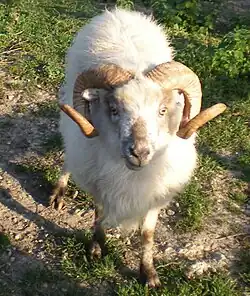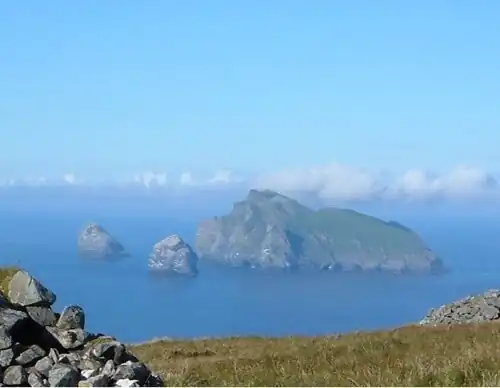Boreray Blackface
 A ram | |
| Conservation status | |
|---|---|
| Other names |
|
| Country of origin | Scotland |
| Distribution | Boreray, St Kilda |
| Use |
|
| Traits | |
| Weight | |
| Height |
|
| Horn status | horned in both sexes[4] |
| |
The Boreray Blackface, also Hebridean Blackface or Boreray,[5]: 274 is a rare Scottish breed of sheep originating on the St Kilda archipelago off the west coast of Scotland and surviving as a feral animal on one of the islands, Boreray. It was once reared for meat and wool, but is now used mainly for conservation grazing. It falls within the Northern European short-tailed group of breeds.[6]: 1276
It is an endangered breed, and in 2025 was classified by the Rare Breeds Survival Trust as "priority", the second level of concern of the trust.[2] It is one of eight rare British breeds registered in the Combined Flock Book, a herd-book established in 1974; the others are the Castlemilk Moorit, the Manx Loaghtan, the Norfolk Horn, the North Ronaldsay, the Portland, the Soay and the Whitefaced Woodland.[7]: 733
St Kilda sheep
St Kilda is a remote archipelago, west of the Outer Hebrides. Several types of sheep have been associated with St Kilda. In addition to the Boreray, these include the Soay sheep, a feral type from Soay (one of the other islands in the St Kilda archipelago), and the Hebridean sheep, which was formerly called the "St Kilda sheep", although the sheep it was derived from were probably not in fact from St Kilda itself.[8][9]
History
Until the late eighteenth century, the domesticated sheep throughout the Scottish Highlands and Islands belonged to a type called the Scottish Dunface or Old Scottish Shortwool, which was probably similar to the sheep kept in the whole of northern and western Europe up to the Iron Age. A local variety of Dunface was kept on the two main St Kilda islands of Boreray and Hirta by the crofters of the islands, who lived on Hirta, the largest island of the archipelago.[10] Modern breeds descended from the Dunface include the Boreray and also the North Ronaldsay and the Shetland.[11]
In the mid-eighteenth century the crofters' sheep were described as being "of the smallest kind", with short, coarse wool, and all having horns – usually one pair, but often two pairs. At that time there were about a thousand of these sheep on Hirta and about four hundred on Boreray.[12]
In the late nineteenth century the crofters' sheep were cross-bred with Scottish Blackface sheep,[13] which by then had replaced the Dunface throughout mainland Scotland.[14]
Before the evacuation of the St Kildian inhabitants, these sheep were farmed.[15] However, when the St Kilda archipelago's human inhabitants were evacuated in 1930, the sheep of Hirta were also removed and in 1932 they were replaced by Soays, which still live there as well as on Soay itself. Meanwhile, the remaining sheep on Boreray were left to become feral;[13] these became the only survivors of the crofters' sheep, and one of the few surviving descendants of the Dunface. This means that they are the original, unmodified sheep that used to be farmed on the island.[16] Six of the sheep were taken in the 1970s to mainland Scotland to form the nucleus of a second breeding population; the number there remains low.[4]
Characteristics

Despite being partially derived from a long-tailed breed (the Scottish Blackface), Borerays display characteristics which group them with other northern European short-tailed sheep. They are amongst the smallest sheep, with mature ewes weighing 28 kg (62 lb) and standing 55 cm (22 in) at the withers.[16]
They have naturally short tails, which do not require docking. They also moult their fleece naturally, rather than having to be shorn annually,[17] though older individuals do not moult as easily and may require additional shearing.[10] Fleeces are grey or creamy white on the body, though darker individuals occur whose colouring is similar to the Soay sheep. Rough in quality, the wool is mostly used in the creation of tweeds or carpet yarns. A tweed is a rough-surfaced coarse cloth, typically made in Scotland. Its colour is a mix of flecked colours.[18] The face and legs are wool-free and black and white, with the proportions varying between individuals.[19]
Both sexes of the Boreray display horns, formerly sometimes more than one pair, but in the modern breed always only one pair. The horns on the ewes tend to be thinner than those on the males and while they curve they do not spiral beyond 360 degrees. Mature rams can grow large, spiral horns[4] which may be used for crafts such as making shepherd's crooks.
Population
In 1999 the population was estimated to be at less than 84, with 74 ewes. In 2002, there were between 92 and 100 animals, with 92 ewes and the male population estimated to be less than 7. In 2012, 204 ewes were registered in herdbooks. Since 2012, sheep numbers have been increasing year on year;[20] and in 2017 the Rare Breeds Survival Trust (RBST) moved the classification of the sheep from 'Category 2: Critical' to 'Category 3: Vulnerable' as the number of breeding ewes was estimated to exceed 500.[21] This data was collected from the herdbooks produced by breed societies, listing all registered sheep, and multiplying the number of registered sheep to account for non-registered sheep.[22]
However, in 2017 the Food and Agriculture Organization of the United Nations estimated that there were 426 breeding ewes.[20]
Use
The breed was primarily reared for meat and wool, but due to its rarity it is now reared for conservation purposes, if reared at all, as most of the population is thought to be feral.[23][3]
Due to the native conditions of where it developed, the Boreray is very well suited to conservation grazing, which is grazing that uses livestock to improve biodiversity and achieve nature conservation in a given area.[24] However, the Rare Breeds Survival Trust believe that this could be further capitalised on if the breed is developed further.[4]
See also
References
- ^ Barbara Rischkowsky, Dafydd Pilling (editors) (2007). List of breeds documented in the Global Databank for Animal Genetic Resources, annex to: The State of the World's Animal Genetic Resources for Food and Agriculture. Rome: Commission on Genetic Resources for Food and Agriculture, Food and Agriculture Organization of the United Nations. ISBN 9789251057629. Archived 23 June 2020.
- ^ a b Watchlist 2025–26. Kenilworth, Warwickshire: Rare Breeds Survival Trust. Archived 27 June 2025.
- ^ a b Breed data sheet: Boreray / United Kingdom of Great Britain and Northern Ireland (Sheep). Domestic Animal Diversity Information System of the Food and Agriculture Organization of the United Nations. Accessed August 2025.
- ^ a b c d e f Boreray. Rare Breeds Survival Trust. Archived 17 August 2025.
- ^ Valerie Porter, Ian Lauder Mason (2002). Mason's World Dictionary of Livestock Breeds, Types, and Varieties (fifth edition). Wallingford: CABI. ISBN 085199430X.
- ^ Ó. R. Dýrmundsson, R. Niżnikowski (2010). North European short-tailed breeds of sheep: a review. Animal. 4(8): 1275-1282. doi:10.1017/S175173110999156X. (subscription required).
- ^ Valerie Porter, Lawrence Alderson, Stephen J.G. Hall, D. Phillip Sponenberg (2016). Mason's World Encyclopedia of Livestock Breeds and Breeding (sixth edition). Wallingford: CABI. ISBN 9781780647944.
- ^ "Hebridean Sheep History". The Hebridean Sheep Society. 2011. Archived from the original on 20 November 2015. Retrieved 21 November 2015.
- ^ "Boreray sheep". Soay Sheep Society. Archived from the original on 18 January 2016. Retrieved 21 November 2015.
- ^ a b "Essex Rare Breeds — Boreray Sheep". Millfields Rare Breeds. Archived from the original on 22 November 2015. Retrieved 7 November 2015.
- ^ Trow-Smith, Robert (3 November 2005). A History of British Livestock Husbandry, 1700-1900. Taylor & Francis. ISBN 978-0-415-38112-3.
- ^ Macaulay, Kenneth (1764). The History of St Kilda. T Becket and P A De Hondt. p. 129.
- ^ a b "Land Mammals". National Trust for Scotland. 2003. Archived from the original on 5 March 2016. Retrieved 22 November 2015.
- ^ "Scottish Dunface history". Hebridean Sheep Society. 2 March 2011. Archived from the original on 22 November 2015. Retrieved 7 November 2015.
- ^ Long, John L. (2003). Introduced Mammals of the World: Their History, Distribution and Influence. Csiro Publishing. p. 527. ISBN 9780643099166.
- ^ a b "Sheep Breeds". Smallholder Series. Archived from the original on 6 April 2016. Retrieved 21 November 2015.
- ^ Cooper, Jane (2023). The Lost Flock. London, UK - Vermont, USA: Chelsea Green Publishing - White River Junction. p. 8. ISBN 9781915294135.
- ^ "Tweed". Oxford English Dictionary. Archived from the original on 22 November 2015. Retrieved 21 November 2015.
- ^ "Wool of the Boreray Sheep". British Coloured Sheep Breeders Association. Archived from the original on 20 November 2015. Retrieved 7 November 2015.
- ^ a b "Breed Information — UK Government". DEFRA. Retrieved 7 November 2015.
- ^ "Publications: Watchlists". Rare Breeds Survival Trust. 2016–2017. Archived from the original on 3 February 2017. Retrieved 23 August 2017.
- ^ "RBST: about the watchlist". Archived from the original on 22 August 2017. Retrieved 22 August 2017.
- ^ "Boreray - Sheep breed". Britannic Rare Breeds. Archived from the original on 20 November 2015. Retrieved 7 November 2015.
- ^ "What is Conservation Grazing?". Open Space Trust. Retrieved 21 November 2015.
